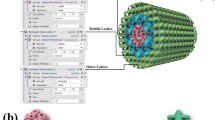Abstract
Many glass applications require laminated glass to achieve a safe load-bearing behaviour. Beside the structural aspect, glass elements have to meet high aesthetic demands. Laminated glasses often feature an offset between the individual glass panes resulting from the lamination process. With regards to visible or exposed edges, this displacement reduces the aesthetic quality of the glass component. The regrinding of the edge after lamination equalises the offset and thus creates a smooth surface. However, regrinding tempered glass leads to a reduction of the surface compression zone at the edge and may decrease the load-bearing capacity. A research project focuses on the detailed evaluation of the effect of regrinding tempered glass. To attain a precise understanding, three different aspects have to be examined: first the maximum required grinding depth resulting from the edge offset, second the defects on the surface of the edge and third the residual stress distribution. The third part was examined by means of stress measurements at the edge and the surface of different specimens. Glass beams made of fully tempered glass and heat strengthened glass with three different thicknesses (6, 8 and 10 mm) were ground after the tempering process. The regrinding depth was 1, 2 and 3 mm. One group of specimens remain untreated as a reference. The depth of the compression zone and the magnitude of the surface stress at the edge were measured with the help of photoelastic measurements. The experimental approach and the results are the content of this paper. It enables a statement about transformations of the residual stress state at the edge owing to regrinding tempered glass.



















Similar content being viewed by others
References
EN 1288-3: Glas im Bauwesen – Bestimmung der Biegefestigkeit von Glas – Teil 3: Prüfung von Proben bei zweiseitiger Auflagerung (Vierschneiden-Verfahren). Deutsches Institut für Bautechnik, Berlin (2000)
Ensslen, F., Müller-Braun, S.: Kantenfestigkeit von Floatglas in Abhängigkeit von wesentlichen Schneidprozessparametern. In: Glasbau 2017, pp. 219–232. Ernst & Sohn, Berlin (2017)
Föppl, L., Mönch, E.: Praktische Spannungsoptik, Dritte edn. Springer, Berlin, Heidelberg, New York (1972)
Kleuderlein, J., Ensslen, F., Schneider, J.: Investigation of edge strength dependent on different types of edge processing. In: Engineered Transparency 2014, pp. 259–268. Technische Universität Darmstadt, Technische Universität Dresden (2014)
Laufs, W.: Ein Bemessungskonzept zur Festigkeit thermisch vorgespannter Gläser. Schriftenreihe Stahlbau—RWTH Aachen; Heft 45. Shaker: Aachen (2000)
Lindqvist, M.: Structural glass strength prediction based on edge flaw characterization. Dissertation, École Polytechnique Fédéreale de Lausanne (2013)
Lohr, K., Weller, B., Engelmann, M.: Influence of regrinding depth on edge strength of tempered glass. In: Challenging Glass 5—Conference on Architectural and Structural Applications of Glass, Ghent (2016)
Nielsen, J. H.: Drilling in tempered glass—modelling and experiments. In: Engineered Transparency Conference 2012, pp. 223–231, Düsseldorf (2012)
Vandebroek, M.: Thermal fracture of glass. Dissertation, Universiteit Ghent (2014)
Acknowledgements
The investigations are conducted as part of a research project supported by the German Federal Ministry of Economic Affairs and Energy. The authors would like to thank the project partner Glaswerkstätten Frank Ahne GmbH for the close co-operation, the technical support and the production of the test specimens. Moreover, we would like to thank ilis gmbH for their support and the appropriation of the StrainScope.
Author information
Authors and Affiliations
Corresponding author
Additional information
Publisher's Note
Springer Nature remains neutral with regard to jurisdictional claims in published maps and institutional affiliations.
Rights and permissions
About this article
Cite this article
Lohr, K., Weller, B. Residual stress distribution in tempered glass with reground edges. Glass Struct Eng 4, 99–115 (2019). https://doi.org/10.1007/s40940-018-0084-7
Received:
Accepted:
Published:
Issue Date:
DOI: https://doi.org/10.1007/s40940-018-0084-7




